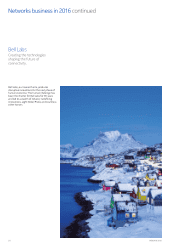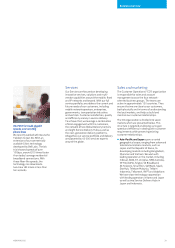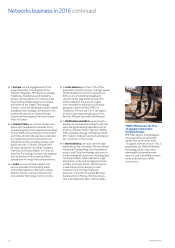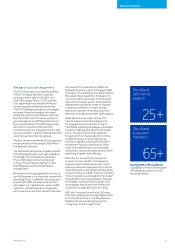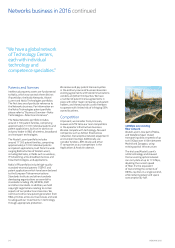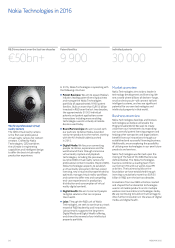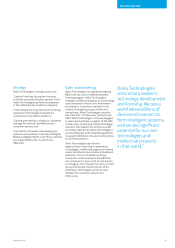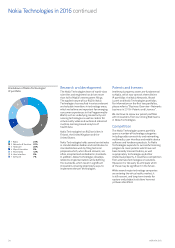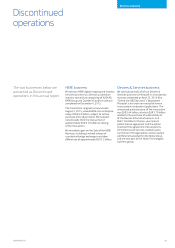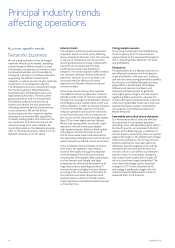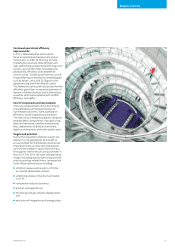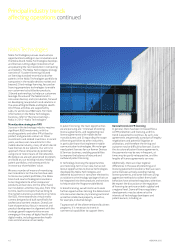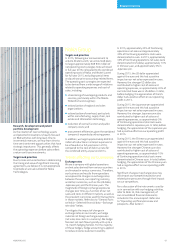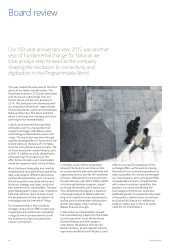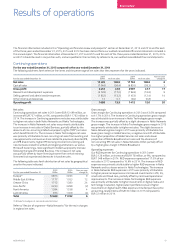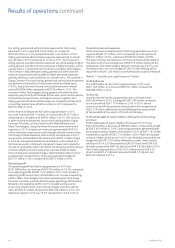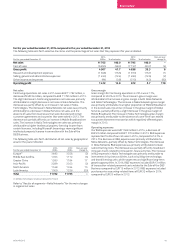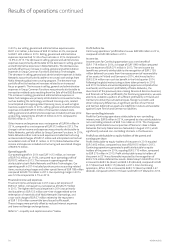Nokia 2015 Annual Report Download - page 42
Download and view the complete annual report
Please find page 42 of the 2015 Nokia annual report below. You can navigate through the pages in the report by either clicking on the pages listed below, or by using the keyword search tool below to find specific information within the annual report.40 NOKIA IN 2015
Pricing and price erosion
The pricing environment intensied during
the rst quarter of 2015 and remained
approximately at the same level throughout
2015, impacting Nokia Networks’ net sales
and protability.
Product mix
The protability of our Networks business is
also aected by product mix including the
share of software in the sales mix. Products
and services have varying protability proles.
For instance, our Mobile Networks business
group oers a combination of hardware,
software and services. Hardware, and
especially software products, generally
havehigher gross margins, but also require
signicant R&D investments, whereas the
service oerings are typically labor-intensive,
while carrying low R&D investment, and have
relatively low gross margins compared to
thehardware and software products of
MobileNetworks.
Seasonality and cyclical nature of projects
Our Networks business’ sales are aected
byseasonality in the network operators’
spending cycles, with generally higher sales in
the fourth quarter, as compared to the rst
quarter of the following year. In addition to
normal industry seasonality, there are normal
peaks and troughs in the deployment of large
infrastructure projects. The timing of these
projects depends on new radio spectrum
allocation, network upgrade cycles and the
availability of new consumer devices and
services, which in turn aects our Networks’
business sales. As an example, during the
lastcouple of years some of the major LTE
roll-outs have been largely completed. The
next major technology cycle is expected
tobegin in 2017 when utilization of 5G
technology is expected to begin, with the
initial commercial deployments currently
expected from 2018 onwards.
Business specic trends
Networks business
We are a leading vendor in the converged
networks infrastructure market, providing
abroad range of dierent products, from
thehardware components of networks used
by network operators and increasingly by
enterprise customers, to software solutions
supporting the ecient interaction of
networks, as well as services to plan, optimize,
implement, run and upgrade networks.
TheNetworks business is conducted through
four business groups: Mobile Networks,
FixedNetworks, IP/Optical Networks and
Applications & Analytics. These business
groups provide an end-to-end portfolio
of hardware, software and services to
enable usto deliver the next generation
of leading networks solutions and services
to our customers. We aim for all four
business groups to be innovation leaders,
drawing onour frontline R&D capabilities
to deliver leading products and services for
our customers, and ultimately ensure the
company’s long-term value creation. For
moreinformation on the Networks business
refer to “Business overview—Nokia in 2016—
Networks business in 2016” above.
Industry trends
The networks industry has witnessed some
important trends in recent years, aecting
also our Networks business. First, the increase
in the use of mobile data services and the
resulting exponential increase in data trac
has led to an increased need for high
performance, quality and reliability in
networks. The continuing data trac increase
has, however, not been directly reected in
operators’ revenue. As a result, there is an
increased need for eciency for both
operators and network infrastructure and
services vendors.
Second, we are witnessing more operator
consolidation driven by operators’ needs to
provide a wider scope of services, especially
through the convergence of disparate network
technologies across mobile, xed, and IP and
optical networks. In order to improve networks
in terms of coverage, capacity and quality,
network operators continue their transition
toall-IP architectures, with an emphasis on
fast access to their networks through copper,
ber, LTE and new digital services delivery.
Weare also seeing similar trends with cable
operators, who are investing to deploy
high-speed networks. Both the xed-mobile
convergence and the transition to all-IP
architectures were major rationales behind
the acquisition of Alcatel Lucent with its IP and
optical networks and xed-access businesses.
Third, in addition to the attempts to reduce
their costs, the operators may need to
increase their agility through the adoption
ofthe emerging Telco Cloud and network
virtualization technologies. Web scale players,
such as Amazon and Google, and large
enterprises are driving the development of
huge data centers, providing seamless IP
interconnection and digital services delivery
on a large scale. IP routing is at the heart of
the telecommunications equipment and
related services industry’s transformation,
impacting xed and mobile broadband as well
as Cloud services.
Principal industry trends
aecting operations


